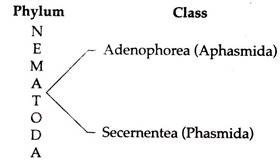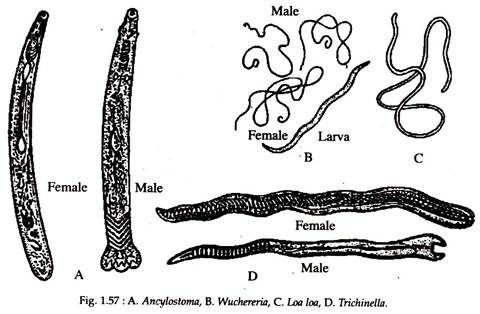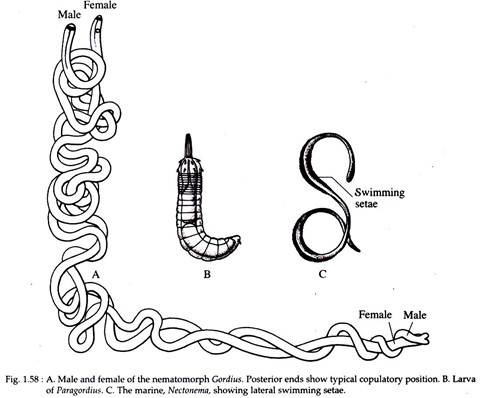In this article we will discuss about Phylum Nematoda:- 1. Introduction to Phylum Nematoda 2. Diagnostic Features of Phylum Nematoda 3. Scheme of Classification 4. Systematic Resume.
Introduction to Phylum Nematoda:
The phylum Nematoda is one of the great success story of the animal kingdom. The nematodes, called round worms, are the largest aschelminth group and include some of the most wide spread and numerous of all multicellular animals.
Their success story revolves on the fact that they are constructed on the same fundamental plan with minor modifications. Thus, the diversity of the species is not based upon the diversity of structure.
Rather their ability to withstand potentially harmful environments has led to their inhabiting various habitats, from the polar region to the tropics, in all types of environment. Some unusual habitat of nematodes includes hot springs where the water temperature may be as high as 53°C.
ADVERTISEMENTS:
A nematode is a ‘tube within a tube’, pointed at both ends and round in cross- section. They generally remain coiled. They are free-living and parasitic. The free living nematodes occur in large numbers in the sea, fresh water and in soil. Terrestrial species live in the water film around soil particles and are actually aquatic.
The large number of parasitic nematodes includes many species of economic and medical importance, and vary greatly in their life cycle.
Etymology:
Greek: nema, thread; eidos, form.
Diagnostic Features of Phylum Nematoda:
i. Nematodes have slender, elongated body with both end gradually tape-ring. They have perfectly cylindrical body adapted for living in minute places.
ADVERTISEMENTS:
ii. Vermiform body, bilaterally symmetrical, but with a tendency to radial symmetry around the longitudinal axis.
iii. Body more than two tell layer thick, with tissues and organs.
iv. The nematode cuticle is much more complex than that of most other aschelminthes.
v. Body wall without circular muscles and made entirely of longitudinal fibers, which are located in four zones—ventral, lateral and two dorsal epidermal chords.
ADVERTISEMENTS:
vi. A caudal gland (also called spinneret) is typical of many free living nematodes, including most marine species which not only provide temporary attachment but may also be used for tail-anchored retreat movements and in springing.
vii. Body cavity is a pseudocoel, usually derived from the blastocoel and is nonexistent in most small free living species.
viii. Muscular gut leading from an anterior mouth through a muscular pharynx and ending in a sub-terminal anus. Teeth or stylets are commonly present in carnivorous and plant-feeding nematodes.
ix. Absence of circulatory system.
x. Excretory system without flame cells or nephridia. Excretory structure comprises of either excretory gland cell or cells (also called a ventral or venette cell), or excretory canal system, or both.
xi. The nervous system comprises of a brain in the form of a circumpharyngeal nerve ring. From the brain extending posteriorly are the dorsal, lateral and ventral nerves that run within the longitudinal muscle cords.
xii. Most nematodes are dioecious, but hermaphroditism is not uncommon.
xiii. Males are generally smaller than females and the posterior end of the male may be curved like a hook or broadened into a fan-shaped copulatory aid called a bursa.
xiv. Fertilization internal and embryonic cleavage pattern neither spiral nor radial, but highly determinate type with ‘T’ shaped arrangement of cells at the four cell stage.
ADVERTISEMENTS:
xv. Development always direct but in parasitic forms larvae may form the infective stages.
Scheme of Classification of Phylum Nematoda:
The phylum nematode consists of more than 15,000 species. Ruppert and Barnes (1994) have classified phylum Nematoda into two classes and 20 orders.
Systematic Resume of Phylum Nematoda:
Class Adenophorea (Aphasmida):
i. The members possess variously shaped amphids behind the lips.
ii. Absence of phasmid in the caudal area.
iii. Presence of cephalic setae and papillae.
iv. Presence of paired testes.
v. Most of the species in this class are free- living (terrestrial and fresh water forms), some are parasitic.
This class comprises of twelve orders.
Examples:
Mondnchus, Dorylaimus, Trichinella (Fig. 1.57D), Trichuris.
Class Secernentea (Phasmida):
i. This class comprises of nematodes that usually possess pore-like amphids in the lateral lips.
ii. In the caudal region there is the presence of a pair of phasmid.
iii. Only anterior testis is present.
iv. Many parasitic forms are member of this class and the free-living species largely inhabit soil.
This class comprises of eight orders.
Examples:
Ascaris (Fig. 1.64), Wuchereria (Fig. 1.57B), Ancylostoma (Fig. 1.57A), Rhabditis, Loa loa (eye-worm) (Fig. 1.58C).


